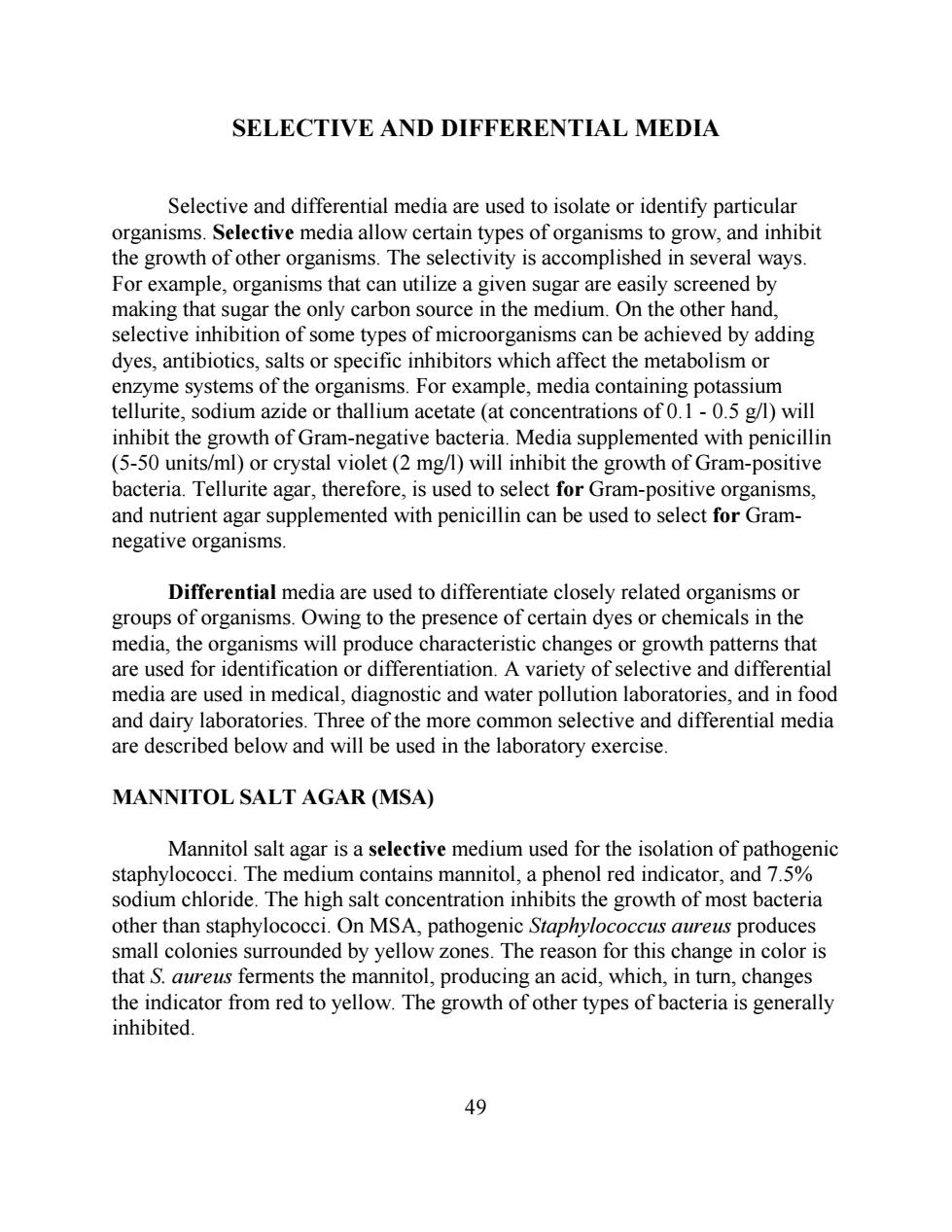正在加载图片...

SELECTIVE AND DIFFERENTIAL MEDIA Selective and differential media are used to isolate or identify particular organisms.Selective media allow certain types of organisms to grow,and inhibit the growth of other organisms.The selectivity is accomplished in several ways. For example,organisms that can utilize a given sugar are easily screened by making that sugar the only carbon source in the medium.On the other hand. selective inhibition of some types of microorganisms can be achieved by adding dyes,antibiotics,salts or specific inhibitors which affect the metabolism or enzyme systems of the organisms.For example,media containing potassium tellurite,sodium azide or thallium acetate (at concentrations of 0.1-0.5 g/l)will inhibit the growth of Gram-negative bacteria.Media supplemented with penicillin (5-50 units/ml)or crystal violet(2 mg/l)will inhibit the growth of Gram-positive bacteria.Tellurite agar,therefore,is used to select for Gram-positive organisms, and nutrient agar supplemented with penicillin can be used to select for Gram- negative organisms. Differential media are used to differentiate closely related organisms or groups of organisms.Owing to the presence of certain dyes or chemicals in the media,the organisms will produce characteristic changes or growth patterns that are used for identification or differentiation.A variety of selective and differential media are used in medical,diagnostic and water pollution laboratories,and in food and dairy laboratories.Three of the more common selective and differential media are described below and will be used in the laboratory exercise. MANNITOL SALT AGAR (MSA) Mannitol salt agar is a selective medium used for the isolation of pathogenic staphylococci.The medium contains mannitol,a phenol red indicator,and 7.5% sodium chloride.The high salt concentration inhibits the growth of most bacteria other than staphylococci.On MSA,pathogenic Staphylococcus aureus produces small colonies surrounded by yellow zones.The reason for this change in color is that S.aureus ferments the mannitol,producing an acid,which,in turn,changes the indicator from red to yellow.The growth of other types of bacteria is generally inhibited. 4949 SELECTIVE AND DIFFERENTIAL MEDIA Selective and differential media are used to isolate or identify particular organisms. Selective media allow certain types of organisms to grow, and inhibit the growth of other organisms. The selectivity is accomplished in several ways. For example, organisms that can utilize a given sugar are easily screened by making that sugar the only carbon source in the medium. On the other hand, selective inhibition of some types of microorganisms can be achieved by adding dyes, antibiotics, salts or specific inhibitors which affect the metabolism or enzyme systems of the organisms. For example, media containing potassium tellurite, sodium azide or thallium acetate (at concentrations of 0.1 - 0.5 g/l) will inhibit the growth of Gram-negative bacteria. Media supplemented with penicillin (5-50 units/ml) or crystal violet (2 mg/l) will inhibit the growth of Gram-positive bacteria. Tellurite agar, therefore, is used to select for Gram-positive organisms, and nutrient agar supplemented with penicillin can be used to select for Gramnegative organisms. Differential media are used to differentiate closely related organisms or groups of organisms. Owing to the presence of certain dyes or chemicals in the media, the organisms will produce characteristic changes or growth patterns that are used for identification or differentiation. A variety of selective and differential media are used in medical, diagnostic and water pollution laboratories, and in food and dairy laboratories. Three of the more common selective and differential media are described below and will be used in the laboratory exercise. MANNITOL SALT AGAR (MSA) Mannitol salt agar is a selective medium used for the isolation of pathogenic staphylococci. The medium contains mannitol, a phenol red indicator, and 7.5% sodium chloride. The high salt concentration inhibits the growth of most bacteria other than staphylococci. On MSA, pathogenic Staphylococcus aureus produces small colonies surrounded by yellow zones. The reason for this change in color is that S. aureus ferments the mannitol, producing an acid, which, in turn, changes the indicator from red to yellow. The growth of other types of bacteria is generally inhibited